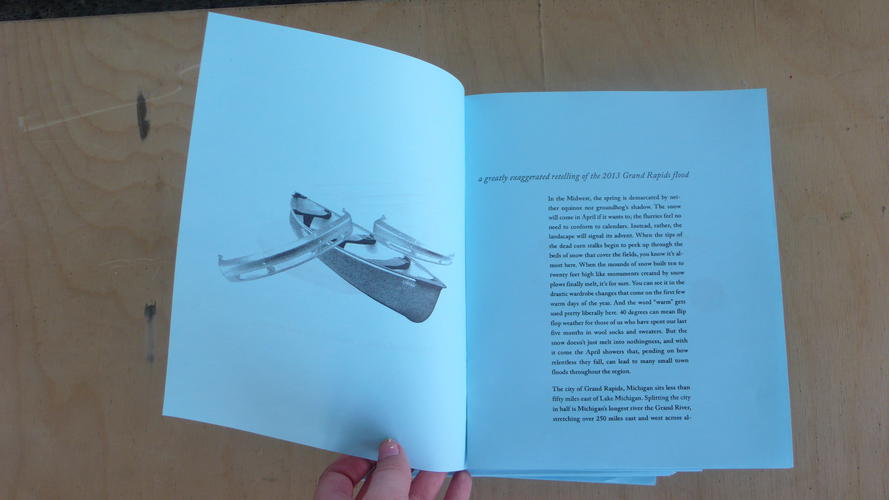Provisional Flood Club
2014



In Times of Urgency Booklet
April 18, 2014"In Times of Urgency, Vulnerability, and Precarity: a Greatly Exaggerated Retelling of the 2013 Grand Rapids Flood" was a booklet produced by the Provisional Flood Club in 2014.
“In the Midwest, the spring is demarcated by neither equinox nor groundhog’s shadow. The snow will come in April if it wants to; the flurries feel no need to conform to calendars. Instead, the landscape will signal its advent. When the tips of the dead corn stalks begin to peek up through the beds of snow that cover the fields you know it’s almost here. When the mounds of snow built ten to twenty feet high like monuments created by snow plows finally melt it’s for sure. You can see it in the drastic wardrobe changes that come on the first few warm days of the year. And the word “warm” gets used pretty liberally here. Forty degrees can mean flip flop weather for those of us who have spent our last five months in wool socks and sweaters. But the snow doesn’t just melt into nothingness, and with it comes the April showers that, pending on how relentlessly they fall, can lead to many small town floods throughout the region.
The city of Grand Rapids, Michigan sits less than fifty miles east of Lake Michigan. Splitting the city in half is Michigan’s longest river, the Grand River, stretching over two-hundred and fifty miles east and west across almost the entire width of the state. In the winter the river freezes over into a giant two-hundred and fifty miles long block of ice, forcing the birds to fly south, but just as with the snow, the ice doesn’t melt into the ether. When the seasons do finally turn, and the snow finally finishes trickling down drip by drip, the River can swell to record-high crests. And when it does the bridges and dams constructed over the past century by scores of men to contain it simply can’t hold it anymore, and the city’s streets bear the burden. Visions fill the city of Toyota sedans halfway submerged in murky lake water, shopping carts dragged blocks and blocks and blocks by the currents, and folks kayaking for reasons far from recreation.
Last year was different though. When the ice melted and the river rose too high for the city’s walls, the streets flooded and the people of Grand Rapids were driven into complete and total paranoia. It started out simple, like any of the other floods the city’s suffered over the years. But when the bridge finally collapsed and the side and west side were both overflown making one giant city/public pool, things took a turn for the worse. Like with any other catastrophic flood, the people quickly headed for higher ground. Families whose homes had been destroyed filled the steeples and bell towers of the various churches of the city. You could look up and see the children peeking their little heads out from the gothic arches like lighthouse keepers. You could also look up and find swarms of people climbing Bridgewater Place and Varnum tower like ants crawling up a burning log for life. US-131 and -196 both collapsed like cheap structures made of paper and glue under the weight of the water. After days of treading for dear life and searching for unoccupied dry space, many undertook a different approach: building an enormous vessel and heading west to and across Lake Michigan for Wisconsin and Illinois for the spring, until the summer sun finally dried up the flooded city streets.
With resources obviously limited by the circumstances of the flood they were forced to replace the traditional materials of boat-building like wood for what found objects made themselves available in the flood. The bow, hull, and stern were formed by the rusted scrap metal of street signs that had been ripped from the ground and floated up to the water’s surface, rendering the boat a reflective rainbow of green highway exit signs, red stop signs, yellow warning signs, and blue city signs. The sail was sewn together from the denim, cotton, and nylon pieces of clothing that had spared getting soaked in the initial flooding, or had dried since. Across it in bright white stitching it read: “Provisional Flood Club: Heading West”, so as to alert anyone wishing to come aboard, similar to the function of those electric signs on the front of public transportation.”
Written by Danny VanZandt with images and design Krzysztof Lower, who printed a single run of fifty copies on soft blue paper using a risograph.